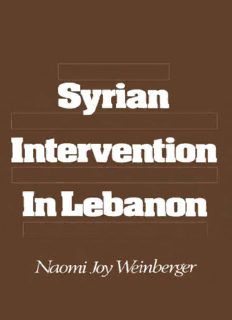
Syrian Intervention in Lebanon PDF
Preview Syrian Intervention in Lebanon
SYRIAN INTERVENTION IN LEBANON This page intentionally left blank SYRIAN INTERVENTION IN LEBANON The 1975-76 Civil War NAOMI JOY WEINBERGER New York Oxford OXFORD UNIVERSITY PRESS 1986 Oxford University Press Oxford New York Toronto Delhi Bombay Calcutta Madras Karachi Petaling Jaya Singapore Hong Kong Tokyo Nairobi Dar es Salaam Cape Town Melbourne Auckland and associated companies in Beirut Berlin Ibadan Nicosia Copyright © 1986 by Oxford University Press, Inc. Published by Oxford University Press, Inc. 200 Madison Avenue, New York. New York 10016 Oxford is a registered trademark of Oxford University Press All rights reserved. No part of this puhlieation may he reproduced, stored in a retrieval system, or transmitted, in any form or by any means. electronic, mechanical, photocopying, recording, or otherwise, without the prior permission of Oxford University Press. Library of Congress C'ataloging-in-Publication Data Weinberger, Naomi Joy. Syrian Intervention in Lebanon. Bibliography: p. Includes index. 1. Lebanon—History—Civil War. 1475-1976. 2. Syria—Foreign relations—Lebanon. 3. Lebanon— Foreign relations—Syria. I. Title. DSX7.5.W45 19X6 956.92'044 86-8353 ISBN 0-19-504010-4 246X9753 I Prinited in the United States of America on acid-free paper To my mother and in memory of my father whose inspiring examples of professional dedication and personal commitment will always guide my endeavors This page intentionally left blank Preface A decade after its initial intervention in Lebanon's civil strife, Syria remains deeply embroiled in its neighbor's dilemmas. This costly engagement stemmed from long-standing ties between the two countries, nourished by Syria's regional leadership ambitions. Yet the goal of restoring stability to Lebanon remains elusive, while the frustration of ongoing occupation bedevils both Lebanese and Syrians. Despite its distinctive characteristics, this case is highly revealing about the dynamics of intervention in general. Many factors fa- vored Syria over other great and small power interveners elsewhere in the globe. Syria was intimately acquainted with its neighbor's political system and society. A multiplicity and diversity of contacts spanning the Lebanese political spectrum yielded manifold chan- nels of influence. By the eve of its intervention in the Lebanese Civil War of 1975-76, the paramountcy of Syrian influence over that of any other external actor was widely acknowledged by Le- banese. Moreover, Syria's bilateral ties with domestic Lebanese parties were augmented by its predominant influence over Pales- tinian guerrillas in Lebanon. Yet despite the advantages of intimacy and influence in the Lebanese arena, Syria fell into the same trap as most interveners in miscalculating the potential costs of its commitment. President Hafiz al-Asad and his advisers were unable to assess correctly the balance of forces between the parties into Lebanon's civil strife. They also erred in overestimating Syria's leverage over its tradi- tional allies in Lebanon. As a consequence of both miscalculations, Syria's expectation that Lebanese stability could be restored through a finite, measured commitment proved invalid. Despite impressive tactical flexibility, Syria was caught in a dynamic of Vlll PREFACE escalation that carried its Lebanese commitment far beyond de- sired limits. A distinguishing feature of Syria's intervention in Lebanon was the fragmented nature of each of the key actors—Lebanon, the Palestine Liberation Organization, and Syria itself. The splintering of Lebanon along sectarian, socioeconomic, and ideological lines— defying clear-cut categories of analysis—gave rise to unstable co- alitions during the Civil War and invited external manipulation. Palestinian guerrilla organizations maintained a symbiotic part- nership with anti-establishment groups in Lebanon, but divisions within Palestinian ranks led to ambivalent relations with Lebanese authorities as well as with Syria. The apparent decisiveness of Syria's authoritarian regime projected a contrasting image of co- herence. In reality, however, the underlying fragmentation of Syr- ian society was a perennial source of apprehension for Syria's leaders. Syrian objectives in Lebanon therefore reflected a gnawing defensiveness, lest Lebanese unrest spark comparable threats to Syria's narrowly based military elite. Baffling associations and divisions, within and across key play- ers, account for the inherent complexity of analyzing Syria's in- tervention in Lebanon. Significantly, realization of Syrian objectives was stymied by these internal divisions rather than by external constraints. Although both regional and great powers sought to influence Syria's Lebanese strategy, neither Arab states, Israel, nor the superpowers fundamentally altered the course of the Syrian intervention. Syria gained pervasive acknowledgment of the paramountcy of its influence, yet the draining commitment in Lebanon ultimately complicated Syria's bid for recognition as a leader in the Arab world. The full saga of Syria's adventure in Lebanon would fill many volumes, and the final outcome is yet to be determined. Striving for depth of analysis, this volume focuses on the opening chapter of Lebanese civil strife—and of the Syrian commitment—in 1975- 76. The developments of subsequent years are alluded to in the concluding chapter and will also provide the motif for my second book, Peacekeeping Strategies: Lessons from Lebanon. The preparation of this book benefited from the inspiration of many colleagues. Those whose constructive criticism helped shape the manuscript include J. C. Hurewitz, Donald J. Puchala, Marius Preface ix K. Deeb, Itamar Rabinovich, William J. Foltz, Richard W. Bulliet, Yaacov Bar-siman-Tov, Robert O. Keohane, Fred Donner, Maan Z. Madina, Lisa Anderson, Raymond Baker, and Mike M. Moch- izuki. The excellent editorial guidance of Susan Rabiner and Joan Bossert at Oxford University Press was also much appreciated, as was Roberta Dulong's dedicated processing of many drafts of the manuscript. I am grateful for access to the research facilities of the Shiloah Institute of Tel Aviv University, whose primary source materials in Arabic were indispensable for this study. Ghassan Nakad paid meticulous attention to the accuracy of my Arabic translations. Generous grants from the Institute for the Study of World Politics and the Josephine de Karman Foundation were enormously help- ful. Beyond a doubt, the warm encouragement and supportiveness of my husband, Dr. Sylvain Weinberger, was the critical ingredient in seeing this project through to completion. May 1986 N.J.W. New Haven, Connecticut
Description: